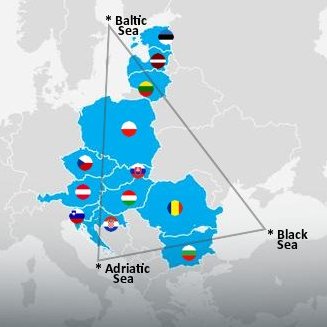«Trimarium»: From the Overture of “Dreamers” to the Techno-Security Union
10.02.2021 0 By NS.WriterAuthors: Victoria VDOVYCHENKO, Ph.D. in World History, Associate Professor, Department of International Relations and International Law, Borys Grinchenko Kyiv University;
Stanislav ZHELIKHOVSKYI, Ph.D. in Political Science, Senior Specialist, Hennadii Udovenko Diplomatic Academy of Ukraine at the Ministry of Foreign Affairs of Ukraine
The area of economic, political, and infrastructural cooperation between the Adriatic, Baltic, and Black Seas, referred to as the «Trimarium», celebrated its first fifth anniversary in 2020.

The Initiative includes Austria, Bulgaria, Estonia, Latvia, Lithuania, Poland, Romania, Slovakia, Slovenia, Hungary, Croatia, and the Czech Republic, bringing together a number of countries willing to strengthen the North-South cooperation and communication, which lacked synergy in their activity. Let us go through the process of how things evolved and proceeded…
The «Investment basket» in Action or the Trimarium Summit in Tallinn 2020
From the very beginning, the participating countries have made considerable efforts to institutionalize this initiative and successfully establish a number of partnerships. The first significant step was Trimarium’s own Investment Fund, the Secretariat, and some commerce chambers. Besides, it obtained the support of 12 Member States and the two largest partners — the United States and Germany. Of the latter countries, only nine maintain the Initiative’s Investment Fund. The largest «investors» are Poland, Romania, Estonia, Latvia, Slovenia, and Hungary. Apart from that, Bulgaria added 20 million euros to this «basket» as the country that will host the Trimarium summit in 2021.
From the start, the Three Seas Initiative has ambitiously determined the right combination of the Baltic, Black and Adriatic Seas in the infrastructure projects. Among the 150 potential projects, the main ones are those related to the energy infrastructure development. The overriding theme for the first Trimarium summits was the need to develop the interconnected infrastructure along the North-South axis, where the energy, economy and security policy are clearly affected by the lack of these networks. This includes constructing the liquefied gas terminals in the Baltic States, Poland and Croatia and the strengthening of digital technology.
In recent years, the Baltic States have been interested in the above-mentioned area, however, from the start of the Initiative they did not believe much in the possibility of its implementation. This will enable the Baltic States to create a regional «gas network» and reduce the EU’s dependence on Russia in the gas sector.
From Washington’s point of view, the Three Seas looks attractive for several reasons. In particular, this concerns strengthening the role of energy and infrastructure projects in Central and Eastern Europe, pushing forward American companies’ energy interests. In addition, the United States view the «Three Seas» as a kind of roadblock for the China’s belt influence (17+1).
As a result, the Trimarium Investment Fund has already received the 1,2 billion euros promised by Mike Pompeo in February 2020. In December of that year, the International Development Finance Corporation (DFC) added another $ 300 million.
«Today, the DFC board approved a $ 2,1 billion investment to develop and support the projects that will enhance the energy security in Eastern Europe, the safe communication networks in Africa and the global fight against Covid-19», the DFC chief Adam Beler wrote on his Twitter. He added: «$ 300 million of this amount will be allocated to the Trimarium Fund».
The pension funds from Canada, South Korea and Japan could become potential investors to the Trimarium fund in the nearest future. This will greatly enhance the political importance and economic capacity of the Initiative. Moreover, in the joint project financing, they also expect the support from the European Investment Bank (EIB), the World Bank, and private investors.
Accordingly, the Fund will be able to raise from 3 to 5 billion euros in the «basket» within the near future. Is that a lot? Not for the full-scale implementation of all infrastructure projects. However, this gives Trimarium more political significance in the short-term future.
Primarily, they have managed to partially achieve the sustainability and synergy of all the actions. At the time when the international projects expenditures were decreasing, it was important to keep the «investment basket» intact and increase the achievements and responsibility for the project’s implementation.
Due to the COVID-19 pandemic, many plans of the participating countries of the «Three Seas» were postponed. Estonia, the country that hosted this year’s summit, had to replan all its activities for a mid-autumn. This, on the one hand, gave the members time to decide on their own agendas for further participation in the «Three Seas Initiative». On the other hand, it gave Estonia more time to get prepared. The summit, which assembled the participants both online and offline, has gathered many ideas for continuing and resuming activities in 2021. Only the presidents of Bulgaria and Poland were able to visit Tallinn in person. All other participants stayed «on the other side» of the computer screens.
The focus on digital transformation and «smart» connectivity was the key. Such a connectivity provides a greater focus on business involvement in transport and energy projects. Not surprisingly, the technology giants Microsoft and Google used the opportunity during the annual «Trimarium» forum in October to declare their interests and have already invested $ 1 billion.
What to expect in 2021?
«In terms of planning, the next year will be as unpredictable as this one, which turned out to be completely unusual. Everyone had plans for this year and most of them were not implemented. The biggest difference of 2021 is that almost no one has a plan, because the situation is very unpredictable», said the head of the Cabinet of the President of Poland Krzysztof Szczerski, answering the questions about Andrzej Duda’s plans for foreign affairs in 2021.
It is clear that in 2021 the challenges will be the same. Unfortunately, the pandemic will not go away. Neither will the «natural» geopolitical opponents of the region amid the seas. Moreover, the United States (perhaps the most ardent supporter of «Trimarium» outside the EU) will change its leader on January 20, 2021. All these factors must be taken into account.
Although Joseph Biden’s team members assure that the newly elected US president, like his predecessor Donald Trump, will place top priority on the Three Seas Initiative, it is important that the union has its own «nuclear» members (both literally and figuratively). The Trimarium does have such.
It is no exaggeration to say that Poland remains one of the main driving forces of the Trimarium. No wonder President Trump attended exactly the Warsaw Summit in 2017, whose presidency was marked by establishing a truly allied relationship between Washington and Warsaw, and the «Three Seas Initiative» entered into a qualitatively new stage.
Poland’s interest in the further development of the Initiative is quite natural. After all, gaining the levers of leadership in the region can guarantee Poland’s security and protection and the region in general. Recognizing this, the United States supports it by all means.
The regional priorities in 2021 are likely to remain the same. According to Minister Szczerski, Poland will develop the «Three Seas Initiative». He also stressed that the association, by means of the «Three Seas» Fund, is already beginning to bring tangible results.
It is clear that no security is complete without energy independence. Therefore, Poland and America’s agreements on the strategic energy infrastructure will continue to be on-trend.
Thus, during the Tallinn summit, they signed the cooperation agreement in the field of nuclear energy development. In December, the Polish government representative on strategic energy infrastructure Piotr Naimski met with the representative of the American Eximbank — which was during the preparation of the financial model of the «atom» construction in Poland involving the Americans.
Thus, in 2021 the United States should submit a proposal to Poland for technological cooperation in the field of construction of Polish nuclear power plants. The Poles must consider their proposal. However, from the beginning, they declare that the United States are the best partner in terms of foreign and security policy.
In parallel, the similar agreements are being discussed between the representatives of the United States and Romania. The Romania’s actions look like the Polish government’s efforts to increase the American presence in Poland’s defense, infrastructure, and energy sectors.
It is worth noting that Eximbank thanked Naimski for «a productive meeting on cooperation between Poland and the United States in the area of „Trimarium“, energy, nuclear energy and infrastructure, as well as for striving for energy independence and economic development».
*****
To crown it all, we say that the Three Seas Initiative is still in the process of being «updated», with more questions in 2020 than answers. It is possible that at the Sofia Summit in 2021, the next steps will be taken to strengthen the region’s sovereignty and security. And of course, we will see which of the planned activities can be realized in times of uncertainty caused by the COVID-19 pandemic.
The publication is carried out in cooperation with Newssky Media Group and the Institute for Democratization and Development.
Публікація здійснюється в рамках співробітництва Newssky Media Group із Інститутом демократизації та розвитку.

